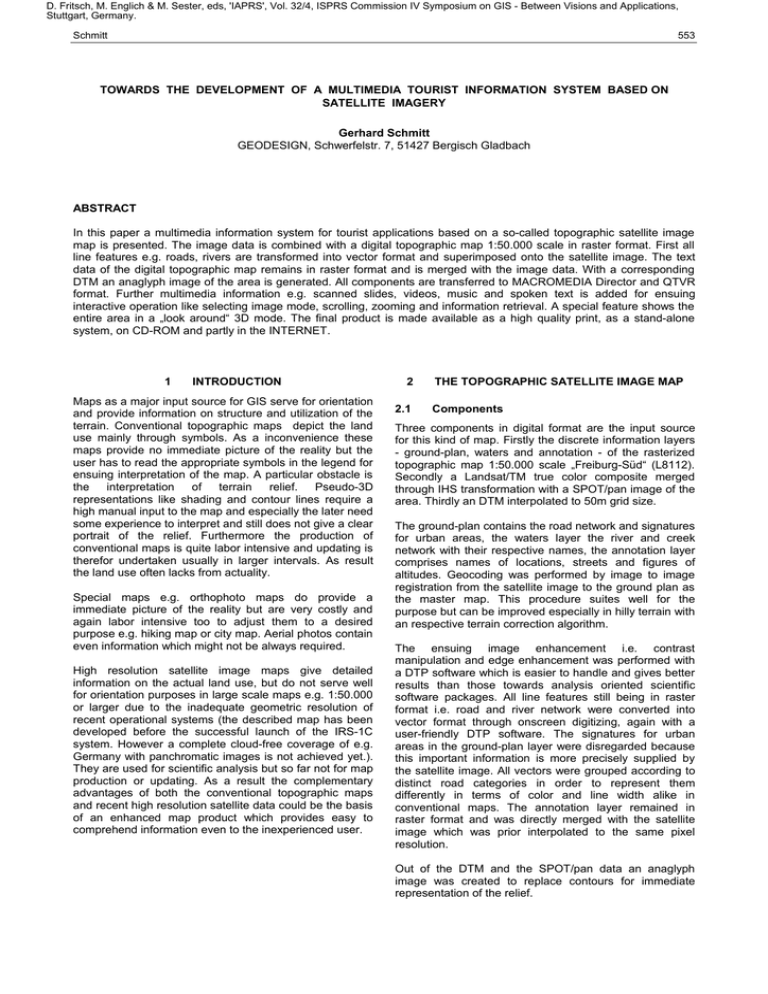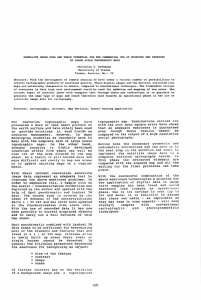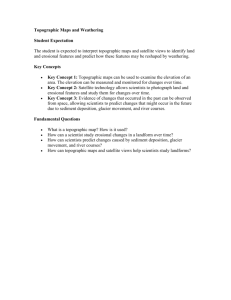TOWARDS THE DEVELOPMENT OF A ... SATELLITE IMAGERY
advertisement

D. Fritsch, M. Englich & M. Sester, eds, 'IAPRS', Vol. 32/4, ISPRS Commission IV Symposium on GIS - Between Visions and Applications, Stuttgart, Germany. Schmitt 553 TOWARDS THE DEVELOPMENT OF A MULTIMEDIA TOURIST INFORMATION SYSTEM BASED ON SATELLITE IMAGERY Gerhard Schmitt GEODESIGN, Schwerfelstr. 7, 51427 Bergisch Gladbach ABSTRACT In this paper a multimedia information system for tourist applications based on a so-called topographic satellite image map is presented. The image data is combined with a digital topographic map 1:50.000 scale in raster format. First all line features e.g. roads, rivers are transformed into vector format and superimposed onto the satellite image. The text data of the digital topographic map remains in raster format and is merged with the image data. With a corresponding DTM an anaglyph image of the area is generated. All components are transferred to MACROMEDIA Director and QTVR format. Further multimedia information e.g. scanned slides, videos, music and spoken text is added for ensuing interactive operation like selecting image mode, scrolling, zooming and information retrieval. A special feature shows the entire area in a „look around“ 3D mode. The final product is made available as a high quality print, as a stand-alone system, on CD-ROM and partly in the INTERNET. 1 INTRODUCTION Maps as a major input source for GIS serve for orientation and provide information on structure and utilization of the terrain. Conventional topographic maps depict the land use mainly through symbols. As a inconvenience these maps provide no immediate picture of the reality but the user has to read the appropriate symbols in the legend for ensuing interpretation of the map. A particular obstacle is the interpretation of terrain relief. Pseudo-3D representations like shading and contour lines require a high manual input to the map and especially the later need some experience to interpret and still does not give a clear portrait of the relief. Furthermore the production of conventional maps is quite labor intensive and updating is therefor undertaken usually in larger intervals. As result the land use often lacks from actuality. Special maps e.g. orthophoto maps do provide a immediate picture of the reality but are very costly and again labor intensive too to adjust them to a desired purpose e.g. hiking map or city map. Aerial photos contain even information which might not be always required. High resolution satellite image maps give detailed information on the actual land use, but do not serve well for orientation purposes in large scale maps e.g. 1:50.000 or larger due to the inadequate geometric resolution of recent operational systems (the described map has been developed before the successful launch of the IRS-1C system. However a complete cloud-free coverage of e.g. Germany with panchromatic images is not achieved yet.). They are used for scientific analysis but so far not for map production or updating. As a result the complementary advantages of both the conventional topographic maps and recent high resolution satellite data could be the basis of an enhanced map product which provides easy to comprehend information even to the inexperienced user. 2 2.1 THE TOPOGRAPHIC SATELLITE IMAGE MAP Components Three components in digital format are the input source for this kind of map. Firstly the discrete information layers - ground-plan, waters and annotation - of the rasterized topographic map 1:50.000 scale „Freiburg-Süd“ (L8112). Secondly a Landsat/TM true color composite merged through IHS transformation with a SPOT/pan image of the area. Thirdly an DTM interpolated to 50m grid size. The ground-plan contains the road network and signatures for urban areas, the waters layer the river and creek network with their respective names, the annotation layer comprises names of locations, streets and figures of altitudes. Geocoding was performed by image to image registration from the satellite image to the ground plan as the master map. This procedure suites well for the purpose but can be improved especially in hilly terrain with an respective terrain correction algorithm. The ensuing image enhancement i.e. contrast manipulation and edge enhancement was performed with a DTP software which is easier to handle and gives better results than those towards analysis oriented scientific software packages. All line features still being in raster format i.e. road and river network were converted into vector format through onscreen digitizing, again with a user-friendly DTP software. The signatures for urban areas in the ground-plan layer were disregarded because this important information is more precisely supplied by the satellite image. All vectors were grouped according to distinct road categories in order to represent them differently in terms of color and line width alike in conventional maps. The annotation layer remained in raster format and was directly merged with the satellite image which was prior interpolated to the same pixel resolution. Out of the DTM and the SPOT/pan data an anaglyph image was created to replace contours for immediate representation of the relief. D. Fritsch, M. Englich & M. Sester, eds, 'IAPRS', Vol. 32/4, ISPRS Commission IV Symposium on GIS - Between Visions and Applications, Stuttgart, Germany. 554 IAPRS, Vol. 32, Part 4 "GIS-Between Visions and Applications", Stuttgart, 1998 Plate 1: Information Layer Ground-Plan: Raster Format (left), Vector Format (right) 2.2 Characteristics Topographic Satellite image maps are expected to provide a better picture of the reality and thus render an enhanced orientation in the field. This applies especially for hiking maps, which are often used by less experienced users The representation of the land use is more detailed and realistic. Through the inherent shading effect in hilly terrain these features are portrayed in a pseudo 3D fashion due to azimuth and elevation angle of the sun during the sensing process. Unfortunately satellite data normally have an southeast illumination which does not comply with the standard north-west illumination of conventional maps which has influenced conventional map reading. However this artificial effect can be simulated with a DTM. Updating of this kind of digital map is relatively easy to accomplish. Changes in land use and in image quality in terms of improved sensors with higher geometric resolution can be taken into consideration by the replacement with an recent satellite image. On the other hand if topographic features are changing e.g. a new road construction, only that part has be digitized and combined with the satellite data The map carrier too is variable. Next to prints, digital media like CD-ROM and INTERNET are possible. 3 3.1 MULTIMEDIA PROCESSING Data capture A variety of different input sources for tourist applications were captured serving as additional information in the GIS environment based on the topographic satellite image map. They consisted of: - music,- spoken text, - videos, - scanned text, photographs and drawings. Wherever possible already existing data were used rather than generate these kind of information anew. The contents of information extended from gastronomy sites (e.g. menu list, opening hours, interior environment, etc.), hiking treks, vantage points, camp sides, historic and other scenic places to so called special features like a cable car. 3.2 Data integration All data were converted into digital format and further processed with the author software „MACROMEDIA Director“ which can provide an output either on a standalone-system, a CD-ROM or using the „Afterburner“ software in INTERNET compatible format. Examples are shown under http://www.geodesign.de. D. Fritsch, M. Englich & M. Sester, eds, 'IAPRS', Vol. 32/4, ISPRS Commission IV Symposium on GIS - Between Visions and Applications, Stuttgart, Germany. Schmitt 555 Plate2: The Graphic User Interface (GUI), showing a subset of the topographic satellite image map 1:50.000 Plate 2 shows a the Graphic User Interface (GUI) of the Tourist-GIS prototype with a subset of the satellite map „Freiburg Süd“, 1:50.000 scale at maximum magnification. The functionality comprises: - zooming, - scrolling at various velocities and directions, - selecting different information layers, - selecting image mode (anaglyph or 2D satellite image), - sound on/off. In each information layer the according symbols e.g. a glass of wine for a restaurant are displayed at the respective location on the map. By clicking on the symbols further second to n-level information of this spot is retrieved. 3.3 Data manipulation To virtually live and explore interactively the terrain a fly through module programmed in QTVR format has been developed and implemented in the prototype. At several vantage points regularly distributed in the entire digital map the user is enabled to look up and downwards and horizontally around his own axis up to 360 degrees (see plate 3). From this points it is possible to click on another one which has the same functionality as described above. The various outlooks are annotated with written and spoken text to provide the user better orientation and detailed meta information at the same time. 4 PROSPECT In the very near future there second generation high resolution sensors like SPOT/2 will be fully replaced by the third generation like IRS1C/D IKONOS or SPOT successors which will provide data up to 2m ground resolution. This will enhance the mapping scale at least to 1:25.000. Consequently the term „high resolution“ will be redefined. But for commercial applications pricing will be crucial. Recent policies do not meet the demands of the non-scientific community which have to calculate their products market oriented to compete with conventional maps, because appealing high tech maps do not necessarily make the end user accept high prices. But on the other hand the entire „spaces business“ i.e. their costly programs do need a wide acceptance in the public to justify long term subsidies. The first step is already the shift from the „top down“ to the „bottom up“ approach in designing sensors according to the demands of the user community This should be followed by adequate pricing. D. Fritsch, M. Englich & M. Sester, eds, 'IAPRS', Vol. 32/4, ISPRS Commission IV Symposium on GIS - Between Visions and Applications, Stuttgart, Germany. 556 IAPRS, Vol. 32, Part 4 "GIS-Between Visions and Applications", Stuttgart, 1998 Plate3: „Look Around“ and „Fly Through“ mode in QVTR format So far the fly through mode is restricted to fixed locations and computed paths which shorten a comprehensive interactive operation of this kind. Surely the PC technology is one bottleneck at present but this will be overcome with the progressing development in this sector. It is believed that the availability of these kinds of products in the INTERNET will play a key role in the future. Digital and subsequently Online geo-information will replace the atlas in the bookshelf like it starts already with geoencyclopedias e.g. Microsoft ENCARTA, collection of photographs from space e.g. D-SAT or a compilation of large-scale maps on CD-ROM distributed by various federal survey offices. Especially if someone wants to plan a travel/holiday at a certain location low cost (multimedia)information of the area is appreciated and would be demanded. Later on the spot conventional analog products e.g. maps will still be indispensable, if the terrain is explored. Satellite remote sensing can satisfy one demand of the coming information society if it is always oriented towards the users needs.






